No products in the cart.
MATHURA & VRINDAVAN: KRISHNA’S LOVE-SOAKED LAND OF BRAJ
Uttar Pradesh
Love and longing are the flavour of Braj, where Lord Krishna, as a beloved child and mischievous youth, spent his formative years. It is here that while tending his cows with his friends, love was first awakened in him for Radha the milkmaid who would come here regularly with her sakhis (friends).
Braj, located in the present-day state of Uttar Pradesh, even today evokes those halcyon days of love and leisurely pursuits of Radha and Krishna by the holy Yamuna and the forested glades. It is here that their love became the inspiration of the beautiful Rasleelas which epitomise that divine and blessed union.

For the devotees of Krishna and his beloved Radha, a lifetime is not enough to recapture the divinity embedded in this sacred land where 1000 festivals a year, 5000 temples, hundreds of villages, forests and water bodies, traditions, folk songs, Raasleelas, Charkula dance performances, Bhagwat Kathas, Vedic schools, and Kirtan singing are the very fabric of life here.
The sacred spaces of Krishna’s Braj Bhoomi, of which Mathura is at the very heart, are encapsulated in a leisurely stretch from Kotban near Hodel to the historic city of Agra (Agarvan, meaning ‘scented forest’). Scattered in between, along the eastern edges of the Trans-Yamuna zone are the villages of Gokul, Mahavan, Baldeo, Mat, and Bajna; along the western flank of the Yamuna, lie Vrindavan, Govardhan, Kusum Sarovar, Barsana and Nandgaon— all of which are associated with Lord Krishna’s early life and times. This lovely stretch by the Yamuna featured a host of fruit orchards, forest groves, cultivated fields, and placid water bodies, creating an idyllic pastoral setting for the Radha-Krishna love story.
This is an especially interesting time to be in Braj with NGOs and government bodies striving to revive it to its green glory.
Iconic Pilgrimage
The Braj circuit forms one of the most important pilgrimage journeys for Hindu devotees from all over the world, especially in the holy period of Kartika (October/November) when one undertakes the ritual parikrama of the sacred sites here.
The Braj circuit offers a veritable treasure trove of deeply rewarding spiritual experiences shared with streams of Krishna followers amongst the temples, holy bathing ghats, and primary spots linked to episodes from the beloved God’s early life. The Yamuna River itself is a key pilgrimage point as it winds one back to important events during his sojourn here.
Safeguarding Krishna
Protected from the evil designs of his maternal uncle Kanas, these early growing years in hiding were secretly spent in Gokul village in the Braj region with his foster parents Yoshoda and Nanda.
Mathura is the primary site of Shri Krishna Janmasthan Bhoomi, with several important shrines and ghats associated with events from Lord Krishan’s life.
Keshav Deo Temple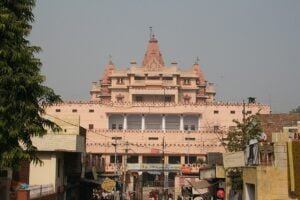
Located in the Shri Krishna Janmasthan temple complex in Mathura is a marble slab in a small underground room in the Keshav Deo Temple. It marks the blessed spot said to be the exact place of Lord Krishna’s birth during the incarceration of his parents, Vasudeva and Devak,’ by his maternal uncle Kansa. The ruler of the Surasena Kingdom, with his capital of Mathura Raja Kansa, lived in fear of a prophecy that the eighth son of Devaki would be the one to kill him and end his rule. Kansa killed all his sister’s seven children but had not taken into account that she would give birth to Krishna, during their imprisonment.
It is believed that the original shrine was built by Vajranabha, the great-grandson of Lord Krishna over 5000 years ago. Contemporary records reveal that the Raja of Orchha built the new shrine during the reign of the Mughal Emperor Jehangir. Subsequently, it was razed by Aurangzeb. The underground temple you see today was rebuilt on the site of the original shrine by the Marathas who had recaptured Mathura from the Mughals.
Vajranabha, the great-grandson of Lord Krishna is believed to have had 16 idols carved for the temples in Brajbhoomi. These are Sri Harideva for Govardhan; Sri Keshava Deva for Mathura; Sri Baladeva for Baladeo; Sri Govind Dev for Vrindavan (now moved to Jaipur); Sr Nathji for Govardhan (now in Nathdwara); Sri Gopinath (now in Jaipur); Sri Madana Mohan (now in Kakroli); Sri Sakshi Gopa (now in Sakshi Gopal, Odisha); Chakleswar for Govardhan; Sri Gopeshwar for Vrindavan; Manasi Devi for Govardhan; Vrinda Devi for Kamavan; Pathal Devi for Mathura; Bhootesheswar for Mathura; Yogayamaya Devi for Vrindavan.
Dwarkadheesh Temple
Located just a short distance away from the Keshav Deo Temple the larger Dwarkadheesh Temple hosts the most elaborate celebrations of Janmashtami, Diwali, and Holi. Not only is the temple decorated and illuminated on these auspicious occasions even the sacred ghats lining the river are given similar treatment. The temple was raised in 1815 by Seth Gokuldas Parikh of Gwalior, who was a deeply dedicated Krishna devotee. The sanctum features a superb rendition of Krishna. During the Krishna Janmotsav celebration, devotees feel deeply blessed witnessing a stream of rituals including the mangal aarti which offers a glimpse of the Lord, the rajbhog (food offering), shringar (adorning Krishna in new robes), and utthapan (awakening the Lord with an elaborate breakfast ritual)
Visitors marvel also at the excellent carvings and murals depicting episodes from the lives of. Another good spot to witness these excellent exemplars of religious art is the Gita Mandir, which also features writings from the Bhagwad Gita; it is located on the Mathura-Vrindavan Road.
Vishram Ghat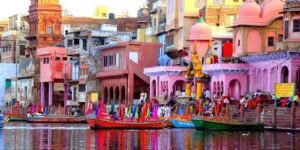
Having killed the tyrannical Raja Kansa Krishna came to Vishram Ghat to seek solitude and solace in the presence of the holy Yamuna. This is the most important of the 25 sacred bathing ghats lining the riverside in Mathura Amongst the many shrines that crowd the ghats the premier ones include the Neelkantheswar Temple, Mukut Temple, Radha- Damodar Temple and Narasimha Temple. Visitors participate in purification rituals and take boat rides on the placid river. The traditional parikrama of all the important religious sites begins and ends here.
Vrindavan, 15km away from Mathura is replete with legends and events in Krishna’s life.
Amongst the popular temples in Vrindavan are the beautiful Banke Bihari Temple, and Madan Mohan Temple which was built by Krishna devotee Kapur Ram Das of Multan. This is one of the oldest temples in Vrindavan. You can also spend prayerful moments at the medieval Govind Dev Temple and the Rangaji Temple marked for the architectural influences of southern India. Another popular line-up is the Shri Radha Vallabhji Temple, Radha Damodar Temple, Radha Gokulananda Temple, Radha Gopinath Temple, Radha Shyamsundar Temple, Radha Raman Temple, Radha Govindadeva Temple, and Radha Madanmohan Temple, all of which are excellent architectural examples of the earliest temples in Vrindavan.
Kesi Ghat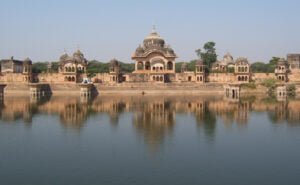
When Krishna slew his wicked uncle Kansa, who appeared to him in the form of a demon horse, at Kesi Ghat in Vrindavan, he did it to protect the people of Braj from his evil deeds. Krishna retired to the Yamuna where he cleansed himself by bathing in the holy waters. The evening aarti at Kesi Ghat is rich in atmospherics.
Shri Bankey Bihari Temple
Even a brief glimpse of the Krishna as a child in this old temple is believed to bring luck to the devotee.
Vrindavan ke ho Banke Bihari, Hum se parda karo na Muraari continues the joyous singing of weekend visitors from Delhi, Interspersed with a robust Sri Banke Bihari Lal ki Jai. Showers of rose petals land everywhere on the black and white chequered floor, men, women, children, families, monks. Tears of joy roll down some cheeks. A sanyasi in saffron, standing and smiling by the pillar at the end of the hall, as if there was no other in the temple courtyard- Just him and beloved Sri Banke Bihari. All eyes are directed on the 3-foot-high idol of love, dressed in clothes of jasmine and rose buds. Just then the curtain is pulled off for a few seconds and then pulled back by the Chief Pujari.
This is the only temple where loud temple bells are not used to wake up Krishna in the morning. Brajwasis say that it is not proper to wake up a child with a start. He is woken gently. There are no bells even for Aarti, as it might disturb Him.
Nidhivan
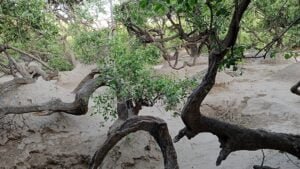 This ancient forest grove lies close to the Rang Mahal Temple. It is said that the divine couple spend time in Rasleela in this grove in secrecy. The idol of Bankey Bihari seen in the Shri Bankey Bihari Temple is said to have been originally consecrated in this basil forest.
This ancient forest grove lies close to the Rang Mahal Temple. It is said that the divine couple spend time in Rasleela in this grove in secrecy. The idol of Bankey Bihari seen in the Shri Bankey Bihari Temple is said to have been originally consecrated in this basil forest.
Shri Radha Raman Temple
Sri Radha Raman temple is among the oldest temples of Vrindavan, established by Gopal Bhatt Goswami (one of the six Goswamis sent by Chaitanya Mahaprabhu to revive Vrindavan). It is next to Nidhivan, where Swami Haridas met Sri Banke Bihari.
ISKCON Temple, Vrindavan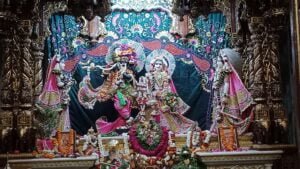
ISKCON, founded by Sri Prabhupada (in the lineage of Chaitanya Mahaprabhu) has temples in many countries. Sri Krishna Balarama Temple in Vrindavan is ISKCON’s international headquarters. The upcoming Chandrodaya temple by ISKCON is set to be the world’s tallest temple.
Sri Radha Damodar Temple
This is where Sri Prabhupada resided before travelling to the west to start ISKCON. The deity Sri Radha Damodar was hand-carved by Chaitanya Mahaprabhu’s disciple Roop Goswami. His Bhajan Kutir here and Samadhis of Vaishnavs make this temple very sacred.
Ancient Tradition of Phool Bangala

Krishna Leela is nature-centric in many ways. A beautiful nature-centric tradition held in Vrindavan is the ritual construction of the temporary phool bangala, or temple house of flowers.
A Phool Bangla is an expression of love and a form of Seva by devotees to the Lord. It is a summer house made of flowers like jasmine, roses, marigolds, and even Ashoka leaves. The tradition appears to date back to the 16th century. Even temple interiors are decorated with flowers and the dresses and jewellery of the deities too are made of flowers.
As the summers are scorching here, the focus is directed on flowers and water fountains; sandalwood and camphor paste, cooling drinks, and food preparations are served to the Lord. A new phool bangala is made every day.
Phool Bangla, or floral decorations starts on Akshay Teej and continues through the summer and rainy season till a day before Hariyali Teej. Spring is at the beck and call of Vrindavan Vihari Krishna. The floral fiesta takes off on Basant Panchmi in spring (January/ February) and wraps up Holi and Rang Panchmi with melodious Rasiya songs, Rasleela, Lathmar Holi, Keech-Holi, Tesu Holi and floral Holi.
It is festive outside the temple as well. A prasad of sweet lassi and kachori is shared by people, cows, monkeys, and maina bird
Mathura Museum
 In the 1st century, under the Buddhist Kushana ruler Kanishka, Buddhist sculptures were mastered at The Mathura School of Art. The Government Museum in Mathura has a large collection of these. The ASI (starting its work in the British period) has excavation sites in Braj and marked many monuments and places as protected sites.
In the 1st century, under the Buddhist Kushana ruler Kanishka, Buddhist sculptures were mastered at The Mathura School of Art. The Government Museum in Mathura has a large collection of these. The ASI (starting its work in the British period) has excavation sites in Braj and marked many monuments and places as protected sites.
From the 11 to 16th centuries, temples and monasteries of Braj, like the rest of North India, were repeatedly destroyed by invaders, and recreated by devotees.
ACCOMMODATION
Both Mathura and Vrindavan, ideal bases for your explorations in the Braj region offer a wide range of hotels, guesthouses, dharmshalas, and ashrams
ACCESS
Air: The nearest airport is Kheria, Agra -62 km away
Rail: Mathura falls on the Delhi-Mumbai main line of North Central Railway. It is well-connected to all major cities.
Road: Located on NH 2, Mathura is well connected to Delhi and other major cities of Uttar Pradesh, Madhya Pradesh, Rajasthan and Haryana
















